Assessment on Anatomy and Physiology
VerifiedAdded on 2020/03/16
|38
|7576
|58
Report
AI Summary
This report presents a comprehensive assessment on anatomy and physiology, covering various systems including the nervous, respiratory, cardiovascular, immune, endocrine, digestive, urinary, and reproductive systems. Each section includes detailed explanations, comparisons, and the physiological functions of these systems, along with relevant tables and figures. The report aims to enhance understanding of human anatomy and physiology, making it a valuable resource for students in healthcare and related fields.
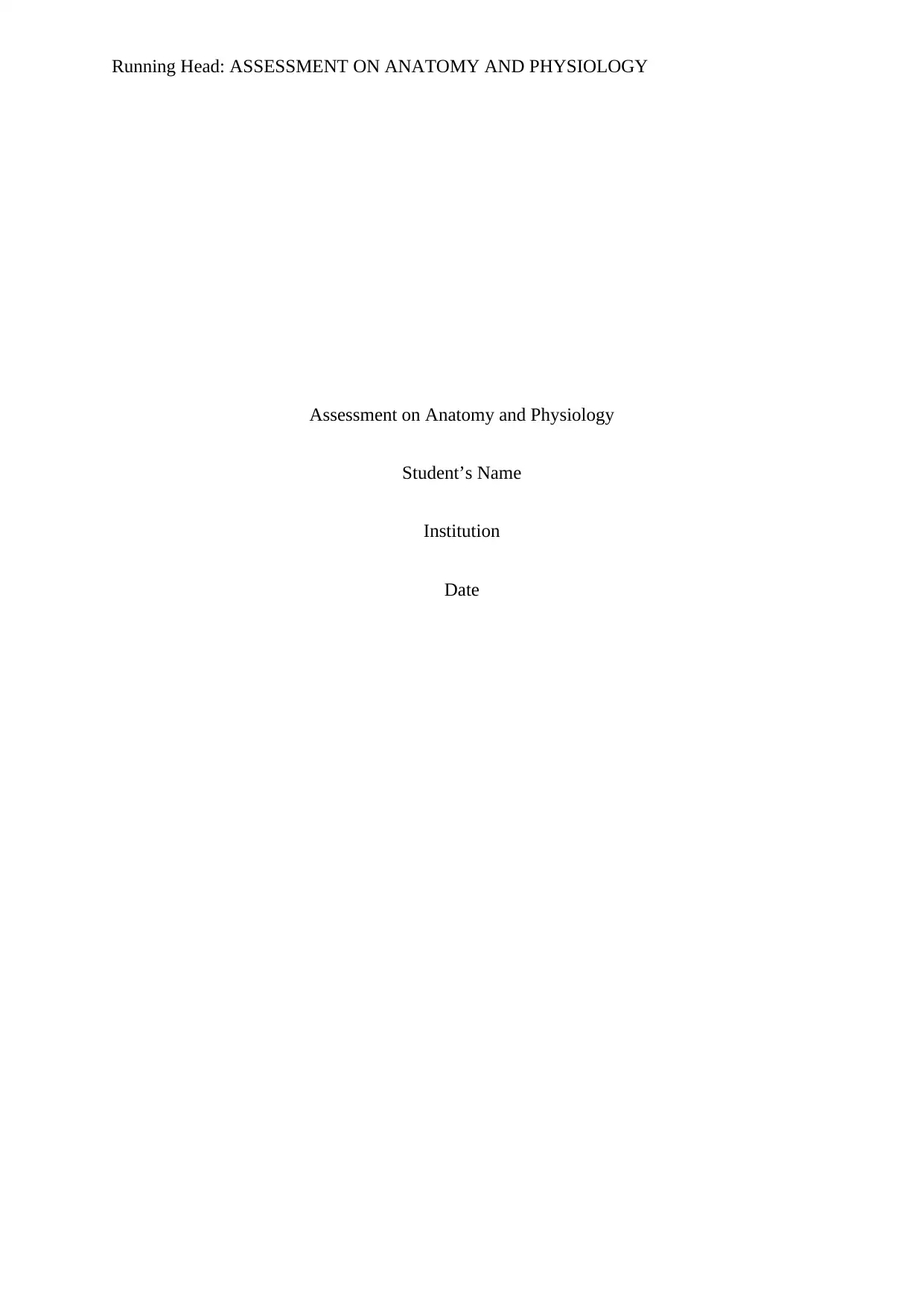
Running Head: ASSESSMENT ON ANATOMY AND PHYSIOLOGY
Assessment on Anatomy and Physiology
Student’s Name
Institution
Date
Assessment on Anatomy and Physiology
Student’s Name
Institution
Date
Paraphrase This Document
Need a fresh take? Get an instant paraphrase of this document with our AI Paraphraser
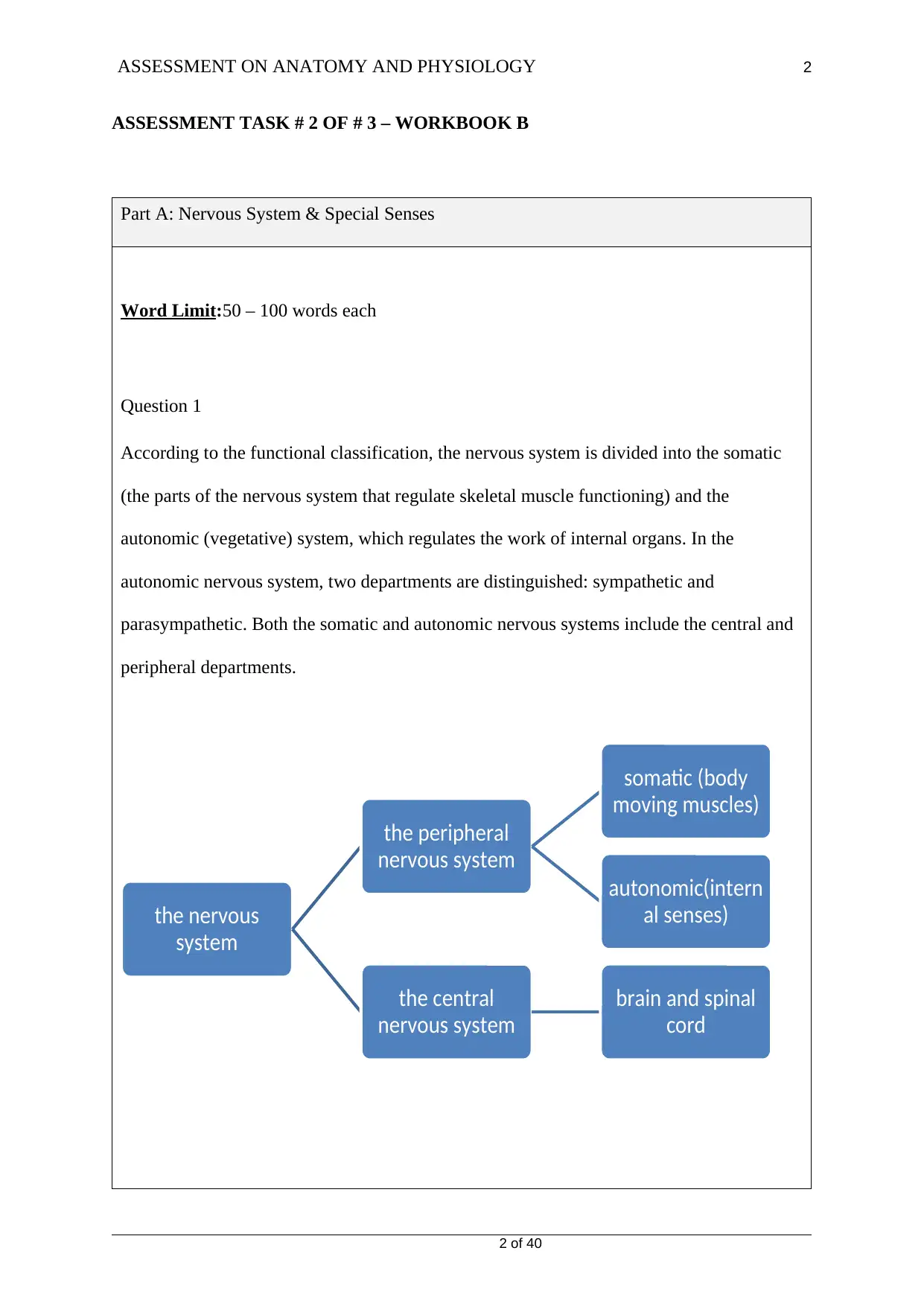
ASSESSMENT ON ANATOMY AND PHYSIOLOGY 2
ASSESSMENT TASK # 2 OF # 3 – WORKBOOK B
Part A: Nervous System & Special Senses
Word Limit:50 – 100 words each
Question 1
According to the functional classification, the nervous system is divided into the somatic
(the parts of the nervous system that regulate skeletal muscle functioning) and the
autonomic (vegetative) system, which regulates the work of internal organs. In the
autonomic nervous system, two departments are distinguished: sympathetic and
parasympathetic. Both the somatic and autonomic nervous systems include the central and
peripheral departments.
2 of 40
the nervous
system
the peripheral
nervous system
somatic (body
moving muscles)
autonomic(intern
al senses)
the central
nervous system
brain and spinal
cord
ASSESSMENT TASK # 2 OF # 3 – WORKBOOK B
Part A: Nervous System & Special Senses
Word Limit:50 – 100 words each
Question 1
According to the functional classification, the nervous system is divided into the somatic
(the parts of the nervous system that regulate skeletal muscle functioning) and the
autonomic (vegetative) system, which regulates the work of internal organs. In the
autonomic nervous system, two departments are distinguished: sympathetic and
parasympathetic. Both the somatic and autonomic nervous systems include the central and
peripheral departments.
2 of 40
the nervous
system
the peripheral
nervous system
somatic (body
moving muscles)
autonomic(intern
al senses)
the central
nervous system
brain and spinal
cord
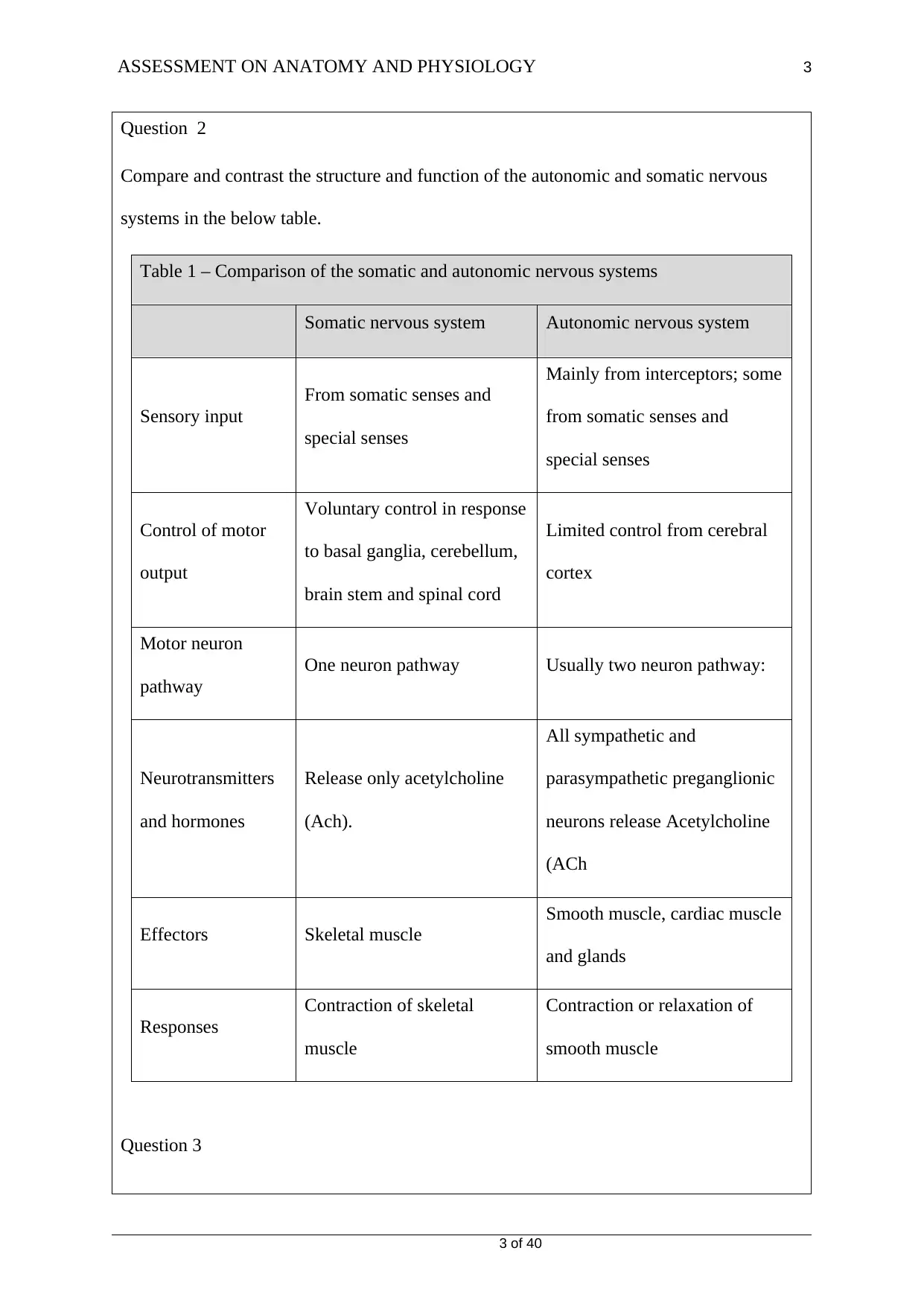
ASSESSMENT ON ANATOMY AND PHYSIOLOGY 3
Question 2
Compare and contrast the structure and function of the autonomic and somatic nervous
systems in the below table.
Table 1 – Comparison of the somatic and autonomic nervous systems
Somatic nervous system Autonomic nervous system
Sensory input
From somatic senses and
special senses
Mainly from interceptors; some
from somatic senses and
special senses
Control of motor
output
Voluntary control in response
to basal ganglia, cerebellum,
brain stem and spinal cord
Limited control from cerebral
cortex
Motor neuron
pathway
One neuron pathway Usually two neuron pathway:
Neurotransmitters
and hormones
Release only acetylcholine
(Ach).
All sympathetic and
parasympathetic preganglionic
neurons release Acetylcholine
(ACh
Effectors Skeletal muscle
Smooth muscle, cardiac muscle
and glands
Responses
Contraction of skeletal
muscle
Contraction or relaxation of
smooth muscle
Question 3
3 of 40
Question 2
Compare and contrast the structure and function of the autonomic and somatic nervous
systems in the below table.
Table 1 – Comparison of the somatic and autonomic nervous systems
Somatic nervous system Autonomic nervous system
Sensory input
From somatic senses and
special senses
Mainly from interceptors; some
from somatic senses and
special senses
Control of motor
output
Voluntary control in response
to basal ganglia, cerebellum,
brain stem and spinal cord
Limited control from cerebral
cortex
Motor neuron
pathway
One neuron pathway Usually two neuron pathway:
Neurotransmitters
and hormones
Release only acetylcholine
(Ach).
All sympathetic and
parasympathetic preganglionic
neurons release Acetylcholine
(ACh
Effectors Skeletal muscle
Smooth muscle, cardiac muscle
and glands
Responses
Contraction of skeletal
muscle
Contraction or relaxation of
smooth muscle
Question 3
3 of 40
⊘ This is a preview!⊘
Do you want full access?
Subscribe today to unlock all pages.

Trusted by 1+ million students worldwide
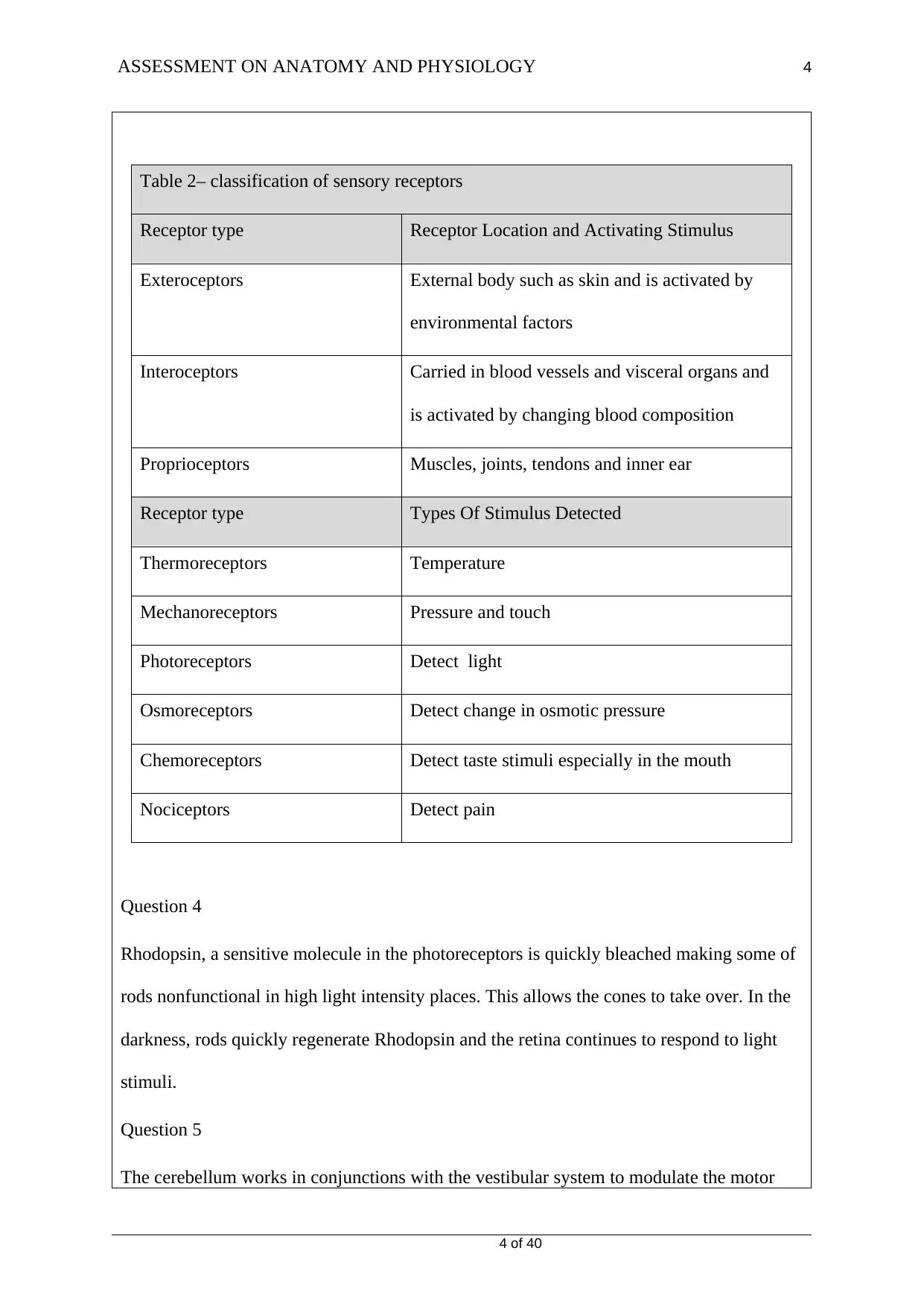
ASSESSMENT ON ANATOMY AND PHYSIOLOGY 4
Table 2– classification of sensory receptors
Receptor type Receptor Location and Activating Stimulus
Exteroceptors External body such as skin and is activated by
environmental factors
Interoceptors Carried in blood vessels and visceral organs and
is activated by changing blood composition
Proprioceptors Muscles, joints, tendons and inner ear
Receptor type Types Of Stimulus Detected
Thermoreceptors Temperature
Mechanoreceptors Pressure and touch
Photoreceptors Detect light
Osmoreceptors Detect change in osmotic pressure
Chemoreceptors Detect taste stimuli especially in the mouth
Nociceptors Detect pain
Question 4
Rhodopsin, a sensitive molecule in the photoreceptors is quickly bleached making some of
rods nonfunctional in high light intensity places. This allows the cones to take over. In the
darkness, rods quickly regenerate Rhodopsin and the retina continues to respond to light
stimuli.
Question 5
The cerebellum works in conjunctions with the vestibular system to modulate the motor
4 of 40
Table 2– classification of sensory receptors
Receptor type Receptor Location and Activating Stimulus
Exteroceptors External body such as skin and is activated by
environmental factors
Interoceptors Carried in blood vessels and visceral organs and
is activated by changing blood composition
Proprioceptors Muscles, joints, tendons and inner ear
Receptor type Types Of Stimulus Detected
Thermoreceptors Temperature
Mechanoreceptors Pressure and touch
Photoreceptors Detect light
Osmoreceptors Detect change in osmotic pressure
Chemoreceptors Detect taste stimuli especially in the mouth
Nociceptors Detect pain
Question 4
Rhodopsin, a sensitive molecule in the photoreceptors is quickly bleached making some of
rods nonfunctional in high light intensity places. This allows the cones to take over. In the
darkness, rods quickly regenerate Rhodopsin and the retina continues to respond to light
stimuli.
Question 5
The cerebellum works in conjunctions with the vestibular system to modulate the motor
4 of 40
Paraphrase This Document
Need a fresh take? Get an instant paraphrase of this document with our AI Paraphraser
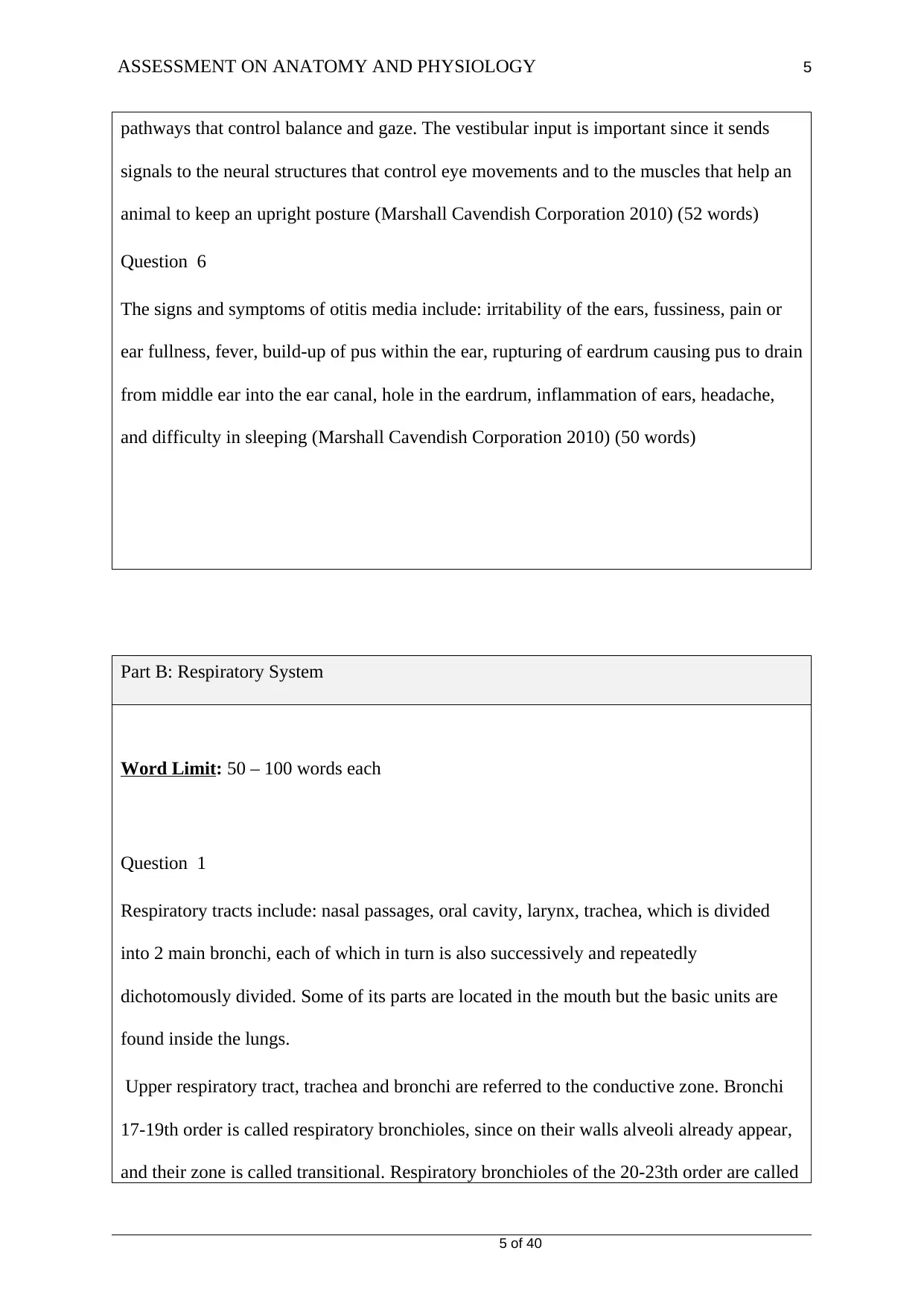
ASSESSMENT ON ANATOMY AND PHYSIOLOGY 5
pathways that control balance and gaze. The vestibular input is important since it sends
signals to the neural structures that control eye movements and to the muscles that help an
animal to keep an upright posture (Marshall Cavendish Corporation 2010) (52 words)
Question 6
The signs and symptoms of otitis media include: irritability of the ears, fussiness, pain or
ear fullness, fever, build-up of pus within the ear, rupturing of eardrum causing pus to drain
from middle ear into the ear canal, hole in the eardrum, inflammation of ears, headache,
and difficulty in sleeping (Marshall Cavendish Corporation 2010) (50 words)
Part B: Respiratory System
Word Limit: 50 – 100 words each
Question 1
Respiratory tracts include: nasal passages, oral cavity, larynx, trachea, which is divided
into 2 main bronchi, each of which in turn is also successively and repeatedly
dichotomously divided. Some of its parts are located in the mouth but the basic units are
found inside the lungs.
Upper respiratory tract, trachea and bronchi are referred to the conductive zone. Bronchi
17-19th order is called respiratory bronchioles, since on their walls alveoli already appear,
and their zone is called transitional. Respiratory bronchioles of the 20-23th order are called
5 of 40
pathways that control balance and gaze. The vestibular input is important since it sends
signals to the neural structures that control eye movements and to the muscles that help an
animal to keep an upright posture (Marshall Cavendish Corporation 2010) (52 words)
Question 6
The signs and symptoms of otitis media include: irritability of the ears, fussiness, pain or
ear fullness, fever, build-up of pus within the ear, rupturing of eardrum causing pus to drain
from middle ear into the ear canal, hole in the eardrum, inflammation of ears, headache,
and difficulty in sleeping (Marshall Cavendish Corporation 2010) (50 words)
Part B: Respiratory System
Word Limit: 50 – 100 words each
Question 1
Respiratory tracts include: nasal passages, oral cavity, larynx, trachea, which is divided
into 2 main bronchi, each of which in turn is also successively and repeatedly
dichotomously divided. Some of its parts are located in the mouth but the basic units are
found inside the lungs.
Upper respiratory tract, trachea and bronchi are referred to the conductive zone. Bronchi
17-19th order is called respiratory bronchioles, since on their walls alveoli already appear,
and their zone is called transitional. Respiratory bronchioles of the 20-23th order are called
5 of 40
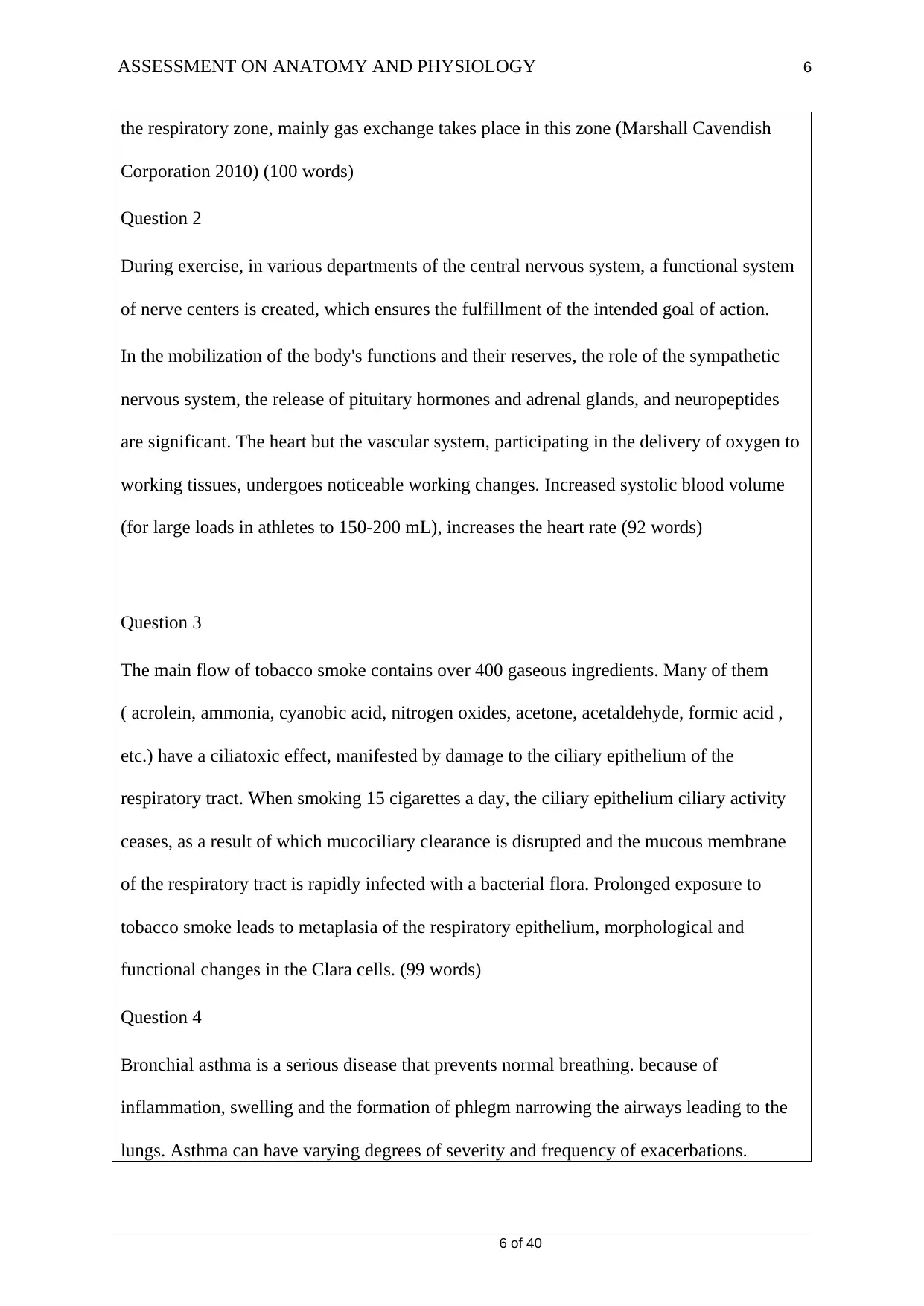
ASSESSMENT ON ANATOMY AND PHYSIOLOGY 6
the respiratory zone, mainly gas exchange takes place in this zone (Marshall Cavendish
Corporation 2010) (100 words)
Question 2
During exercise, in various departments of the central nervous system, a functional system
of nerve centers is created, which ensures the fulfillment of the intended goal of action.
In the mobilization of the body's functions and their reserves, the role of the sympathetic
nervous system, the release of pituitary hormones and adrenal glands, and neuropeptides
are significant. The heart but the vascular system, participating in the delivery of oxygen to
working tissues, undergoes noticeable working changes. Increased systolic blood volume
(for large loads in athletes to 150-200 mL), increases the heart rate (92 words)
Question 3
The main flow of tobacco smoke contains over 400 gaseous ingredients. Many of them
( acrolein, ammonia, cyanobic acid, nitrogen oxides, acetone, acetaldehyde, formic acid ,
etc.) have a ciliatoxic effect, manifested by damage to the ciliary epithelium of the
respiratory tract. When smoking 15 cigarettes a day, the ciliary epithelium ciliary activity
ceases, as a result of which mucociliary clearance is disrupted and the mucous membrane
of the respiratory tract is rapidly infected with a bacterial flora. Prolonged exposure to
tobacco smoke leads to metaplasia of the respiratory epithelium, morphological and
functional changes in the Clara cells. (99 words)
Question 4
Bronchial asthma is a serious disease that prevents normal breathing. because of
inflammation, swelling and the formation of phlegm narrowing the airways leading to the
lungs. Asthma can have varying degrees of severity and frequency of exacerbations.
6 of 40
the respiratory zone, mainly gas exchange takes place in this zone (Marshall Cavendish
Corporation 2010) (100 words)
Question 2
During exercise, in various departments of the central nervous system, a functional system
of nerve centers is created, which ensures the fulfillment of the intended goal of action.
In the mobilization of the body's functions and their reserves, the role of the sympathetic
nervous system, the release of pituitary hormones and adrenal glands, and neuropeptides
are significant. The heart but the vascular system, participating in the delivery of oxygen to
working tissues, undergoes noticeable working changes. Increased systolic blood volume
(for large loads in athletes to 150-200 mL), increases the heart rate (92 words)
Question 3
The main flow of tobacco smoke contains over 400 gaseous ingredients. Many of them
( acrolein, ammonia, cyanobic acid, nitrogen oxides, acetone, acetaldehyde, formic acid ,
etc.) have a ciliatoxic effect, manifested by damage to the ciliary epithelium of the
respiratory tract. When smoking 15 cigarettes a day, the ciliary epithelium ciliary activity
ceases, as a result of which mucociliary clearance is disrupted and the mucous membrane
of the respiratory tract is rapidly infected with a bacterial flora. Prolonged exposure to
tobacco smoke leads to metaplasia of the respiratory epithelium, morphological and
functional changes in the Clara cells. (99 words)
Question 4
Bronchial asthma is a serious disease that prevents normal breathing. because of
inflammation, swelling and the formation of phlegm narrowing the airways leading to the
lungs. Asthma can have varying degrees of severity and frequency of exacerbations.
6 of 40
⊘ This is a preview!⊘
Do you want full access?
Subscribe today to unlock all pages.

Trusted by 1+ million students worldwide
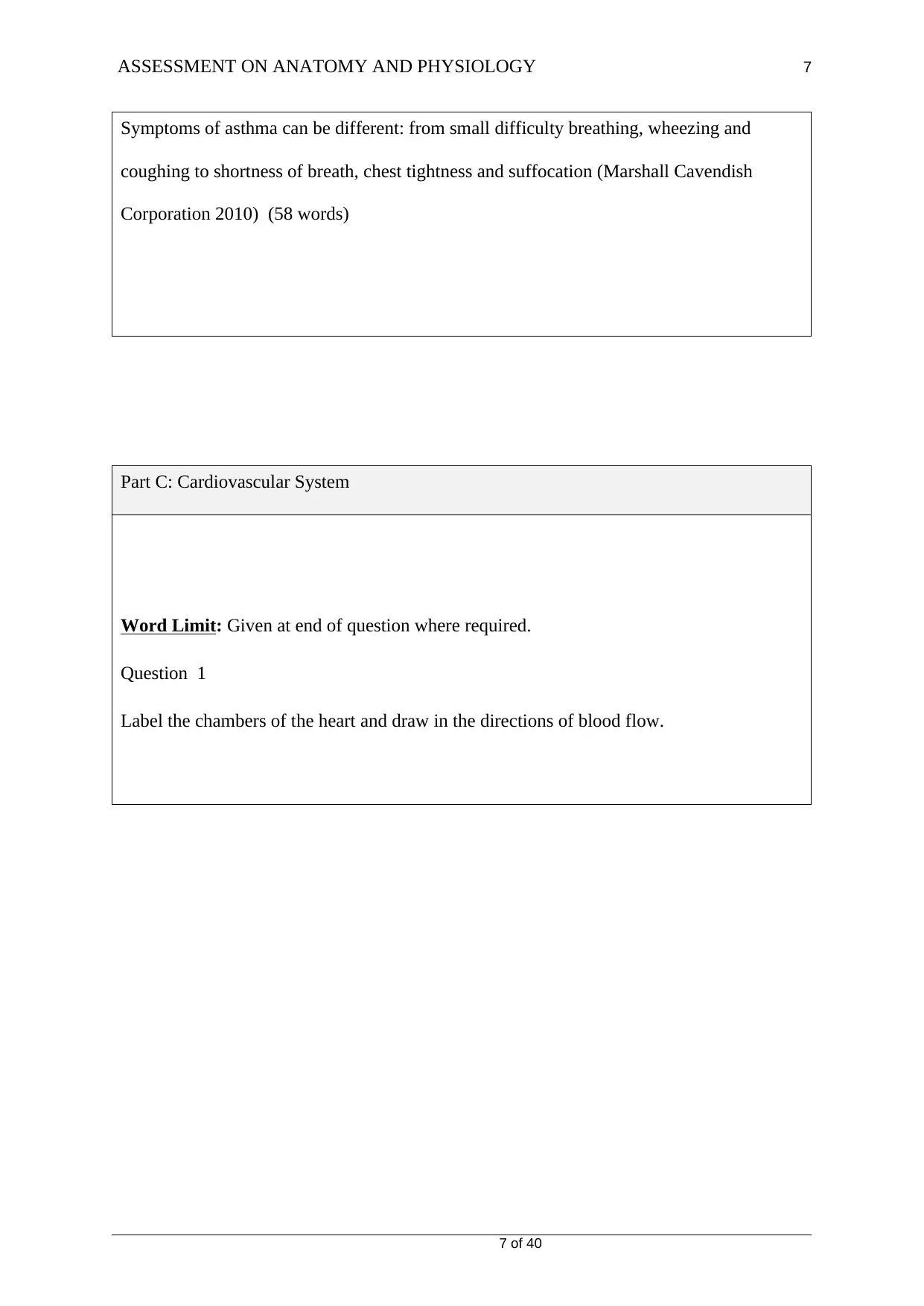
ASSESSMENT ON ANATOMY AND PHYSIOLOGY 7
Symptoms of asthma can be different: from small difficulty breathing, wheezing and
coughing to shortness of breath, chest tightness and suffocation (Marshall Cavendish
Corporation 2010) (58 words)
Part C: Cardiovascular System
Word Limit: Given at end of question where required.
Question 1
Label the chambers of the heart and draw in the directions of blood flow.
7 of 40
Symptoms of asthma can be different: from small difficulty breathing, wheezing and
coughing to shortness of breath, chest tightness and suffocation (Marshall Cavendish
Corporation 2010) (58 words)
Part C: Cardiovascular System
Word Limit: Given at end of question where required.
Question 1
Label the chambers of the heart and draw in the directions of blood flow.
7 of 40
Paraphrase This Document
Need a fresh take? Get an instant paraphrase of this document with our AI Paraphraser
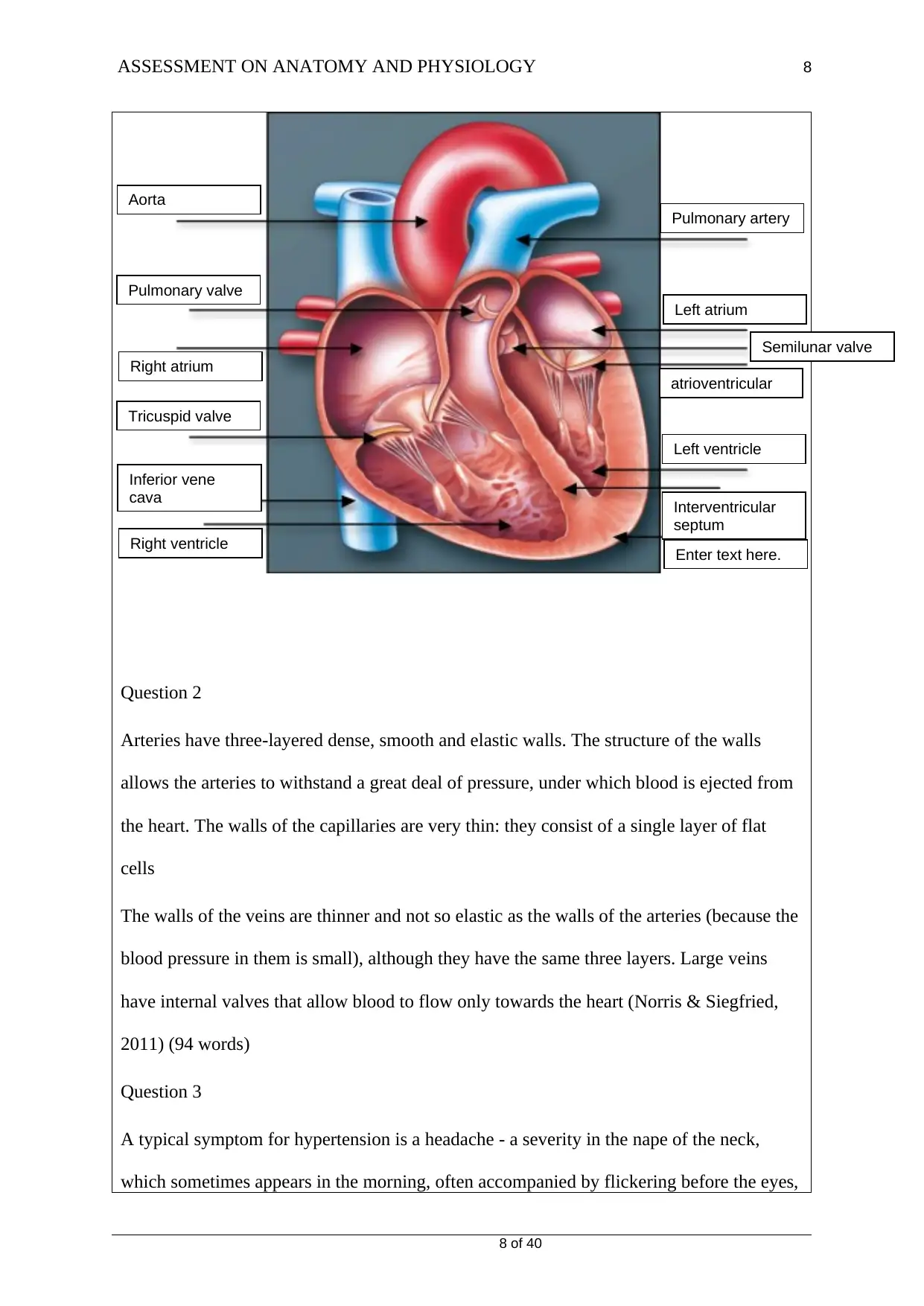
ASSESSMENT ON ANATOMY AND PHYSIOLOGY 8
Question 2
Arteries have three-layered dense, smooth and elastic walls. The structure of the walls
allows the arteries to withstand a great deal of pressure, under which blood is ejected from
the heart. The walls of the capillaries are very thin: they consist of a single layer of flat
cells
The walls of the veins are thinner and not so elastic as the walls of the arteries (because the
blood pressure in them is small), although they have the same three layers. Large veins
have internal valves that allow blood to flow only towards the heart (Norris & Siegfried,
2011) (94 words)
Question 3
A typical symptom for hypertension is a headache - a severity in the nape of the neck,
which sometimes appears in the morning, often accompanied by flickering before the eyes,
8 of 40
Aorta
Pulmonary valve
Right atrium
Tricuspid valve
Inferior vene
cava
Right ventricle
Pulmonary artery
Left atrium
atrioventricular
Left ventricle
Interventricular
septum
Enter text here.
Semilunar valve
Question 2
Arteries have three-layered dense, smooth and elastic walls. The structure of the walls
allows the arteries to withstand a great deal of pressure, under which blood is ejected from
the heart. The walls of the capillaries are very thin: they consist of a single layer of flat
cells
The walls of the veins are thinner and not so elastic as the walls of the arteries (because the
blood pressure in them is small), although they have the same three layers. Large veins
have internal valves that allow blood to flow only towards the heart (Norris & Siegfried,
2011) (94 words)
Question 3
A typical symptom for hypertension is a headache - a severity in the nape of the neck,
which sometimes appears in the morning, often accompanied by flickering before the eyes,
8 of 40
Aorta
Pulmonary valve
Right atrium
Tricuspid valve
Inferior vene
cava
Right ventricle
Pulmonary artery
Left atrium
atrioventricular
Left ventricle
Interventricular
septum
Enter text here.
Semilunar valve
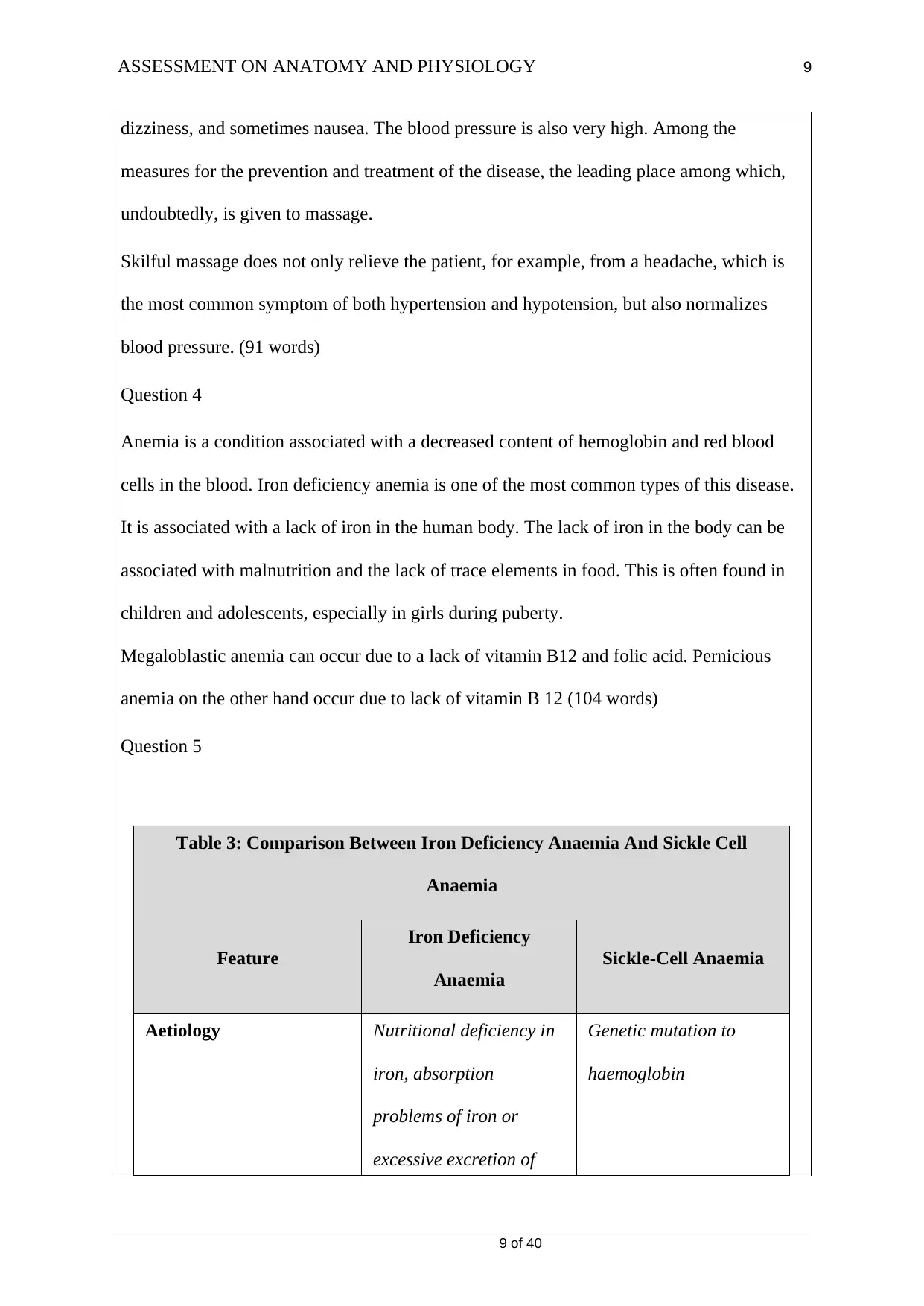
ASSESSMENT ON ANATOMY AND PHYSIOLOGY 9
dizziness, and sometimes nausea. The blood pressure is also very high. Among the
measures for the prevention and treatment of the disease, the leading place among which,
undoubtedly, is given to massage.
Skilful massage does not only relieve the patient, for example, from a headache, which is
the most common symptom of both hypertension and hypotension, but also normalizes
blood pressure. (91 words)
Question 4
Anemia is a condition associated with a decreased content of hemoglobin and red blood
cells in the blood. Iron deficiency anemia is one of the most common types of this disease.
It is associated with a lack of iron in the human body. The lack of iron in the body can be
associated with malnutrition and the lack of trace elements in food. This is often found in
children and adolescents, especially in girls during puberty.
Megaloblastic anemia can occur due to a lack of vitamin B12 and folic acid. Pernicious
anemia on the other hand occur due to lack of vitamin B 12 (104 words)
Question 5
Table 3: Comparison Between Iron Deficiency Anaemia And Sickle Cell
Anaemia
Feature
Iron Deficiency
Anaemia
Sickle-Cell Anaemia
Aetiology Nutritional deficiency in
iron, absorption
problems of iron or
excessive excretion of
Genetic mutation to
haemoglobin
9 of 40
dizziness, and sometimes nausea. The blood pressure is also very high. Among the
measures for the prevention and treatment of the disease, the leading place among which,
undoubtedly, is given to massage.
Skilful massage does not only relieve the patient, for example, from a headache, which is
the most common symptom of both hypertension and hypotension, but also normalizes
blood pressure. (91 words)
Question 4
Anemia is a condition associated with a decreased content of hemoglobin and red blood
cells in the blood. Iron deficiency anemia is one of the most common types of this disease.
It is associated with a lack of iron in the human body. The lack of iron in the body can be
associated with malnutrition and the lack of trace elements in food. This is often found in
children and adolescents, especially in girls during puberty.
Megaloblastic anemia can occur due to a lack of vitamin B12 and folic acid. Pernicious
anemia on the other hand occur due to lack of vitamin B 12 (104 words)
Question 5
Table 3: Comparison Between Iron Deficiency Anaemia And Sickle Cell
Anaemia
Feature
Iron Deficiency
Anaemia
Sickle-Cell Anaemia
Aetiology Nutritional deficiency in
iron, absorption
problems of iron or
excessive excretion of
Genetic mutation to
haemoglobin
9 of 40
⊘ This is a preview!⊘
Do you want full access?
Subscribe today to unlock all pages.

Trusted by 1+ million students worldwide
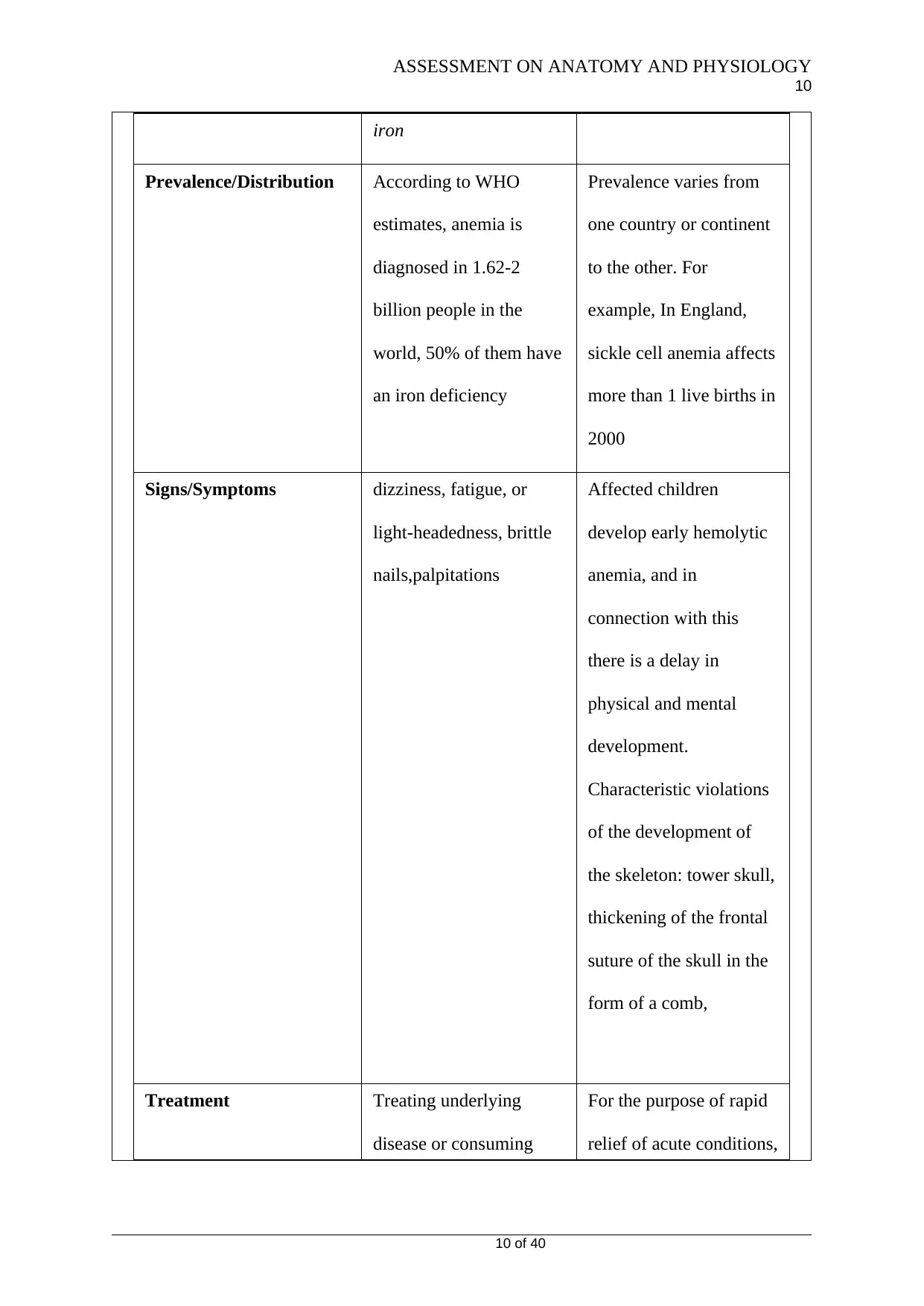
ASSESSMENT ON ANATOMY AND PHYSIOLOGY
10
iron
Prevalence/Distribution According to WHO
estimates, anemia is
diagnosed in 1.62-2
billion people in the
world, 50% of them have
an iron deficiency
Prevalence varies from
one country or continent
to the other. For
example, In England,
sickle cell anemia affects
more than 1 live births in
2000
Signs/Symptoms dizziness, fatigue, or
light-headedness, brittle
nails,palpitations
Affected children
develop early hemolytic
anemia, and in
connection with this
there is a delay in
physical and mental
development.
Characteristic violations
of the development of
the skeleton: tower skull,
thickening of the frontal
suture of the skull in the
form of a comb,
Treatment Treating underlying
disease or consuming
For the purpose of rapid
relief of acute conditions,
10 of 40
10
iron
Prevalence/Distribution According to WHO
estimates, anemia is
diagnosed in 1.62-2
billion people in the
world, 50% of them have
an iron deficiency
Prevalence varies from
one country or continent
to the other. For
example, In England,
sickle cell anemia affects
more than 1 live births in
2000
Signs/Symptoms dizziness, fatigue, or
light-headedness, brittle
nails,palpitations
Affected children
develop early hemolytic
anemia, and in
connection with this
there is a delay in
physical and mental
development.
Characteristic violations
of the development of
the skeleton: tower skull,
thickening of the frontal
suture of the skull in the
form of a comb,
Treatment Treating underlying
disease or consuming
For the purpose of rapid
relief of acute conditions,
10 of 40
Paraphrase This Document
Need a fresh take? Get an instant paraphrase of this document with our AI Paraphraser
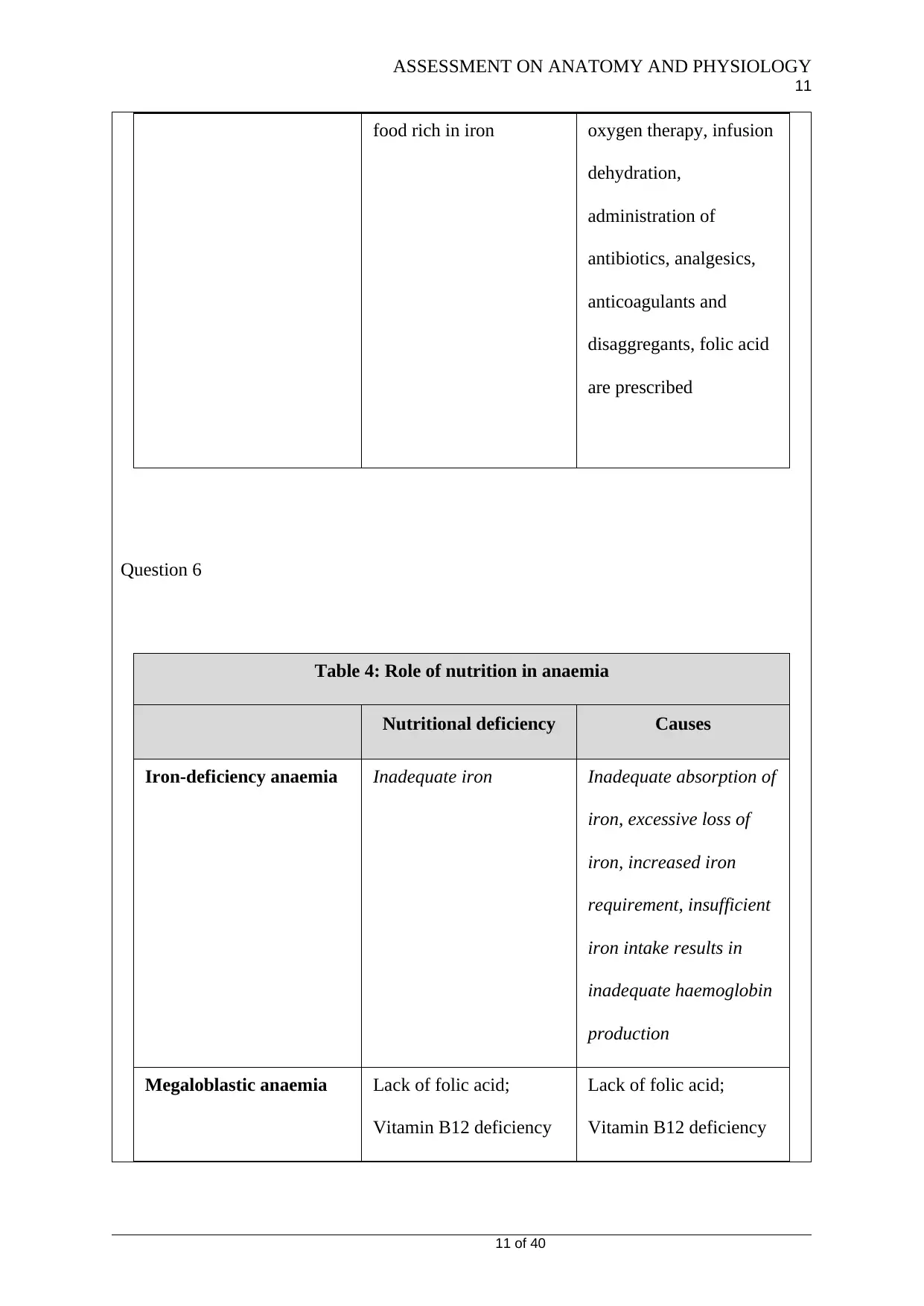
ASSESSMENT ON ANATOMY AND PHYSIOLOGY
11
food rich in iron oxygen therapy, infusion
dehydration,
administration of
antibiotics, analgesics,
anticoagulants and
disaggregants, folic acid
are prescribed
Question 6
Table 4: Role of nutrition in anaemia
Nutritional deficiency Causes
Iron-deficiency anaemia Inadequate iron Inadequate absorption of
iron, excessive loss of
iron, increased iron
requirement, insufficient
iron intake results in
inadequate haemoglobin
production
Megaloblastic anaemia Lack of folic acid;
Vitamin B12 deficiency
Lack of folic acid;
Vitamin B12 deficiency
11 of 40
11
food rich in iron oxygen therapy, infusion
dehydration,
administration of
antibiotics, analgesics,
anticoagulants and
disaggregants, folic acid
are prescribed
Question 6
Table 4: Role of nutrition in anaemia
Nutritional deficiency Causes
Iron-deficiency anaemia Inadequate iron Inadequate absorption of
iron, excessive loss of
iron, increased iron
requirement, insufficient
iron intake results in
inadequate haemoglobin
production
Megaloblastic anaemia Lack of folic acid;
Vitamin B12 deficiency
Lack of folic acid;
Vitamin B12 deficiency
11 of 40
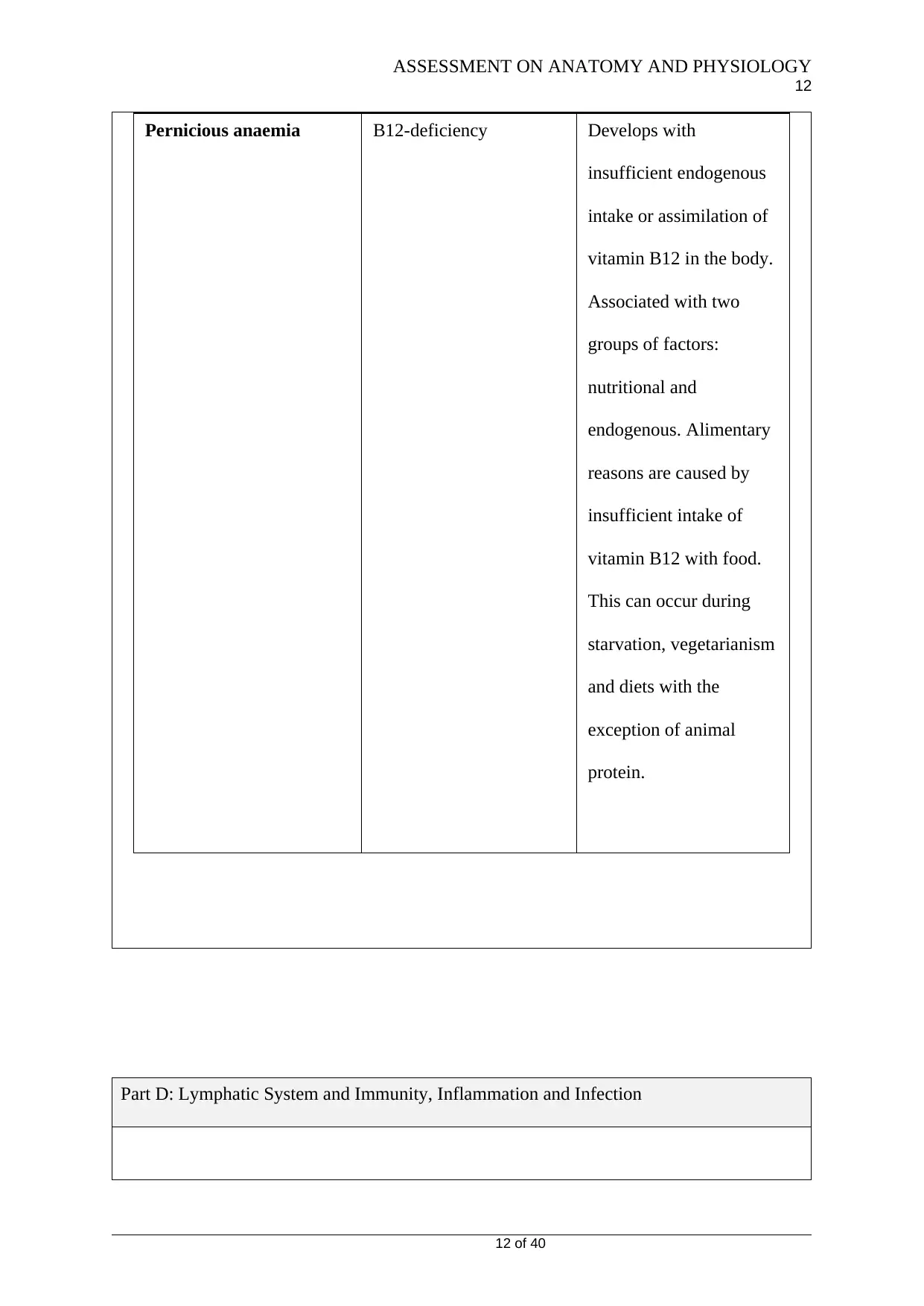
ASSESSMENT ON ANATOMY AND PHYSIOLOGY
12
Pernicious anaemia B12-deficiency Develops with
insufficient endogenous
intake or assimilation of
vitamin B12 in the body.
Associated with two
groups of factors:
nutritional and
endogenous. Alimentary
reasons are caused by
insufficient intake of
vitamin B12 with food.
This can occur during
starvation, vegetarianism
and diets with the
exception of animal
protein.
Part D: Lymphatic System and Immunity, Inflammation and Infection
12 of 40
12
Pernicious anaemia B12-deficiency Develops with
insufficient endogenous
intake or assimilation of
vitamin B12 in the body.
Associated with two
groups of factors:
nutritional and
endogenous. Alimentary
reasons are caused by
insufficient intake of
vitamin B12 with food.
This can occur during
starvation, vegetarianism
and diets with the
exception of animal
protein.
Part D: Lymphatic System and Immunity, Inflammation and Infection
12 of 40
⊘ This is a preview!⊘
Do you want full access?
Subscribe today to unlock all pages.

Trusted by 1+ million students worldwide
1 out of 38
Your All-in-One AI-Powered Toolkit for Academic Success.
+13062052269
info@desklib.com
Available 24*7 on WhatsApp / Email
![[object Object]](/_next/static/media/star-bottom.7253800d.svg)
Unlock your academic potential
Copyright © 2020–2025 A2Z Services. All Rights Reserved. Developed and managed by ZUCOL.